|
 Metaphors are
important even if they remain unstated. The modern conception of an
economy is dominated by the theory of neoclassical economics, whose
metaphor is hidden from view for a very good reason: the field would
look ridiculous if its roots were front and center. But in the
spirit of “Know the truth and it will set you free”, your humble
correspondent will attempt to lay bare the foundation of
neoclassical economics, and, after having done so, propose a more
rational view of economic systems. Metaphors are
important even if they remain unstated. The modern conception of an
economy is dominated by the theory of neoclassical economics, whose
metaphor is hidden from view for a very good reason: the field would
look ridiculous if its roots were front and center. But in the
spirit of “Know the truth and it will set you free”, your humble
correspondent will attempt to lay bare the foundation of
neoclassical economics, and, after having done so, propose a more
rational view of economic systems.
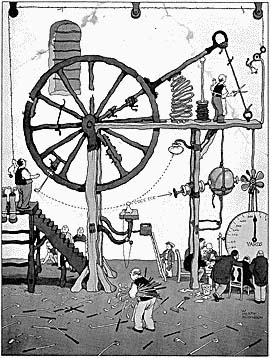 More
heat than light More
heat than light
The grand view of life on which neoclassical economics is based
is as a system of pipes filled with gas or water. In fact, one of
the giants of economics early in the 20th century, Irving Fisher of
Yale, actually constructed a model of the economy which was
simulated by a miniature plumbing system; his mentor was one of the
pioneers of statistical mechanics. The reason for this peculiar
metaphor is that such a conception allows for economists to excel in
the application of the mathematical techniques used by physicists,
and in particular, the methods of statistical mechanics.
Much of modern neoclassical economics is based on the work of a
French engineer Leon Walras. His General Equilibrium Theory is so
important that most economic work must pass the test of being
compatible with his theory. Walras, who wrote in the late 19th
century, was fascinated by the reigning scientific theory of the
day, statistical mechanics (he is said to have kept a copy of a
mechanics textbook next to his bed at night).[1] Even though Darwin had finally
published his work on evolution, the “big thing” in science was
physics, and the big thing in physics, besides the burgeoning field
of electrical science, was statistical mechanics.
Classical mechanics, developed by Isaac Newton, dealt with the
interaction of two bodies with each other; it would take until far
into the 20th century to use Newton’s theory to understand the
interaction of even three bodies (i.e. “three body
problem), and even now the math is very difficult. The beauty of
statistical mechanics is that it is possible to deal with very large
quantities of elements in a statistical manner, using linear algebra
and systems of equations, and thereby predict the behavior of fluids
such as water and gases such as air, which are made up of billions
of molecules.
There are three main properties of a system that can be
successfully addressed by statistical mechanics:
1) There are a large amount of elements;
2) the elements are all the same (homogenous), and therefore,
no element or set of elements serves a particular function; and
3) elements are not created, destroyed or changed into other
kinds of elements, but stay constant.
Just so, a competitive industry has many firms, they are assumed
to be all the same, and though firms go into and out of existence,
the capital that they use to produce their goods is assumed to be
constant, and technology is assumed not to change. No set of firms
serves any specific function.
Neoclassical economics is able to use very powerful analytical
tools for explaining behavior within competitive industrial sectors
with no technological change. These analytical techniques are very
effective in the short-term; calculus, after all, is a way to
understand forces instantaneously, that is, practically without
reference to time. In the grand scheme of general equilibrium
theory, prices are all determined according to the various supply
and demand factors spread throughout the economy, and prices are
determined instantaneously. Time does not exist, technological
change does not exist, and perhaps most surprisingly, capital, or at
least fixed capital,[2] does not exist.
Capital illiteracy
The existence of capital has always been a big problem in the
field of economics. The “problem” with capital is that it makes more
of itself – in other words, it breaks the assumptions of statistical
mechanics, that elements are not created or destroyed.[3] Capital reproduces itself –
sort of like living things within ecosystems, in fact. Capital
therefore inherently creates positive feedback loops – that is, the
increase of something increases the chances that the thing will
increase even further. But if you put positive feedback loops into a
system of fluids or gases, you get what is called turbulence – and
thus was born the field of “chaos” theory, or more properly,
nonlinear dynamics, within the fields of physics and chemistry. But
neoclassical economics is definitely not amenable to positive
feedback loops.[4] And so, if the choice is
between throwing out neoclassical economic theory or capital, the
choice is obvious – capital, be gone!
Thus, economists
- can’t explain economic growth,
- can’t integrate capital or technological innovation into
their models, and
- can’t explain how the various industries in an economy fit
together.
Other than that, it’s a great theory. It can explain how and why
prices change, within a particular competitive industry, in a very
short period of time.
As luck would have it, just as neoclassical economics was
solidifying by using the cutting-edge of physics, physics passed
economics by and embarked on the great period of the elaboration of
the theories of relativity and quantum physics. By the late 20th
century, biology had surpassed physics as the most important science
– in other words, it got more funding – and ecosystem and
evolutionary theory could not only incorporate phenomena like
reproduction, change, and growth, these concepts became the very
core of these sciences.
Metaphor Evolution
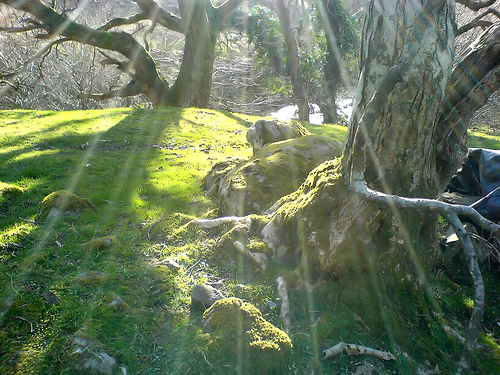 Ecosystems
are not conceived of as a set of similar elements, they are modeled
as a set of functional niches, a set of elements including climate,
landscape, plants, animals or fungi, set within a complex whole. The
pieces all fit together. There are not a large enough number of
niches to enable the use of statistical methods. The largest
aggregation of niches in an ecosystem are called trophic levels,
which is a fancy way of saying that plants produce the main biomass
of an ecosystem; herbivores (mainly) consume what the plants
produce; and carnivores consume the herbivores (sometimes called
secondary consumers). Finally, there are the detrivores such as
worms, fungi and bacteria that break down the dead plant and animal
life, and make the released resources available to the producers in
the form of soil. Within each level there may be greater detail,
such as the various parts of a tree, or depths in a lake or ocean,
and these are considered separate niches. Ecosystems
are not conceived of as a set of similar elements, they are modeled
as a set of functional niches, a set of elements including climate,
landscape, plants, animals or fungi, set within a complex whole. The
pieces all fit together. There are not a large enough number of
niches to enable the use of statistical methods. The largest
aggregation of niches in an ecosystem are called trophic levels,
which is a fancy way of saying that plants produce the main biomass
of an ecosystem; herbivores (mainly) consume what the plants
produce; and carnivores consume the herbivores (sometimes called
secondary consumers). Finally, there are the detrivores such as
worms, fungi and bacteria that break down the dead plant and animal
life, and make the released resources available to the producers in
the form of soil. Within each level there may be greater detail,
such as the various parts of a tree, or depths in a lake or ocean,
and these are considered separate niches.
The species within a niche may change in the process of
evolution, but the niche endures; the niches may eventually be
reconfigured, but the ecosystem is sustained. Scientists studying
the dynamics of ecosystems and species change do not dismiss change
as in neoclassical economics, they spend most of their time trying
to understand it.
 Each
niche serves a particular function, and if enough of these functions
collapse, the entire ecosystem will collapse. For instance, at one
point killer whales had eliminated most sea otters from parts of the
pacific northwest. Without sea otters to eat them, the sea urchin
population exploded, almost eliminating the kelp forests that were
critical to the survival of most species. Only by bringing the sea
otter back from the brink was the ecosystem saved. E.O. Wilson calls
species such as the sea otter a keystone species,
because some species are very central to the functioning of an
ecosystem.[5] For similar reasons, wolves
have been reintroduced in parts of the American west, in order to
keep deer under control that would otherwise devastate plant
niches . Each
niche serves a particular function, and if enough of these functions
collapse, the entire ecosystem will collapse. For instance, at one
point killer whales had eliminated most sea otters from parts of the
pacific northwest. Without sea otters to eat them, the sea urchin
population exploded, almost eliminating the kelp forests that were
critical to the survival of most species. Only by bringing the sea
otter back from the brink was the ecosystem saved. E.O. Wilson calls
species such as the sea otter a keystone species,
because some species are very central to the functioning of an
ecosystem.[5] For similar reasons, wolves
have been reintroduced in parts of the American west, in order to
keep deer under control that would otherwise devastate plant
niches .
Neoclassical economics cannot admit of concepts such as keystone
species or self-reinforcing change or structure based on function.
As I have argued on this site, manufacturing is an absolutely
essential part of a modern wealthy economy. Manufacturing, it might
be said, is like a keystone species. Without the functionality of
manufacturing, the economy collapses. Manufacturing is actually more
like a trophic level, that is, it is the main production subsystem
of the larger system known as the economy. What is produced is then
distributed, in what we may call a distribution system. In the
distribution system of the economy we find retail, wholesale,
services such as advertising, and perhaps most importantly, finance,
which redirects the surplus generated by the production system.
Services are almost always produced using or servicing goods, so
the service sector of an economy may be seen as a level that both
“consumes” (or uses) manufactured goods and produces services.
Within manufacturing we can identify three further levels, or
stages. The outermost stage is the arena of the production of
consumer goods, such as cars or clothes. In order to create these
consumer goods, production machinery must be produced; it is the
production machinery that is used within a factory or construction
site that makes consumer goods possible.
Finally, at the very center of the production system we have what
I have called “reproduction machinery”, machines such as machine
tools, steel-making machinery, electricity-producing turbines, and
semiconductor-making machinery, that both make more of themselves
and produce production machinery. Unlike General Equilibrium Theory,
fixed capital – machinery, essentially – is at the heart of the
economic system.
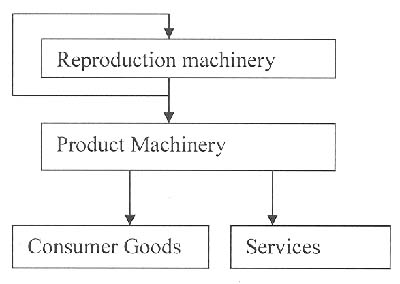
Without all of these levels – distribution, services, consumer
goods, production machinery, and reproduction machinery – a modern,
wealthy economy would not be possible. The economy is an ecosystem,
not a system of pipes.
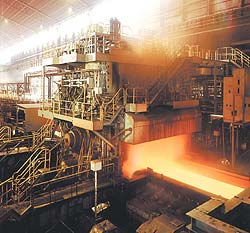 Metaphor
Metaphysics Metaphor
Metaphysics
Each of these levels of production can also be divided into a
category of production – a way of looking at each level to see what
functions are served by various kinds of goods. For instance,
steel-making machinery is the most important way of creating a
material. Creating a material – steel, cloth, wood, plastic – is
essential to any manufacturing system. So a
material-making function is a critical function. Once
we have a material, that material must be shaped into something
useful – an axle, wood part in a piece of furniture, shape of cloth
– which is done by certain types of machinery, such as machine
tools, woodworking machinery, or textile machinery. Just as the
Greeks discussed form and content, so it is useful to talk about a
structure-forming category of production and a
material-making category of production. Metaphysics is also
MetaEngineering.
In order to create form and content, we need two other categories
of production – information-processing and energy
conversion . The “computer revolution”, and more recently, the
internet boom, has contributed greatly to the productivity of
manufacturing, in addition to retailing and searching. Without the
widespread use of electricity, we would have a much lower standard
of living, because manufacturing would be a much more difficult
thing to do.
However, it is in the energy category in particular that we find,
shall we say, a certain difficulty: fossil fuels come from outside
the production system. Oil, coal, and natural gas exploration,
extraction, and refining are among the most sophisticated
manufacturing technologies yet developed, and most fossil fuels
would not be usable without them; the reason fossil fuels are used
and valued is because they power machinery. However, the fossil
fuels themselves come from the Earth
Towards a modern energy sector
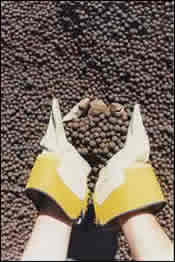 Ideally,
the raw materials of an industrial system should be almost free.
Iron and silicon, the basis of steel and semiconductors, are both
very abundant in the Earth’s crust. The category of material-making
is often very dependent on much scarcer materials, however. As the
recent rise in commodity prices indicates, we are coming to the end
of the period when raw materials were cheap and easy to find.
Indeed, considering that mining is one of the most environmentally
destructive activities known to man or nature,[6] the true costs of raw materials
has never been ascertained by the market. However, we are now at the
point that most steel is being recycled, and it should be possible
to provide for most if not all raw materials through recycling from
now on. Ideally,
the raw materials of an industrial system should be almost free.
Iron and silicon, the basis of steel and semiconductors, are both
very abundant in the Earth’s crust. The category of material-making
is often very dependent on much scarcer materials, however. As the
recent rise in commodity prices indicates, we are coming to the end
of the period when raw materials were cheap and easy to find.
Indeed, considering that mining is one of the most environmentally
destructive activities known to man or nature,[6] the true costs of raw materials
has never been ascertained by the market. However, we are now at the
point that most steel is being recycled, and it should be possible
to provide for most if not all raw materials through recycling from
now on.
Fossil fuels, on the other hand, can’t even be recycled. Assuming
that replacing them with biofuels is problematic, the obvious
solution is truly renewable energy, that is, using wind, solar
power, and geothermal and water power as the energy source, and
constructing machinery to capture these sources of energy. Humans
should concentrate on what they are good at, creating machinery, not
what they are bad at, managing resources.
Because the energy sector, and to a lesser extent, the materials
sector, are using up their own supply, the current global economic
system is heading for collapse, just as any ecosystem that is using
up the basis for its production would eventually collapse. Collapse
is different than catastrophe, or as it has been termed in the
literature, “release”;[7] forest fires are part of the
forest’s natural cycle, and indeed the forest ecosystem is dependent
on occasional fires. Even a meteor hitting the Earth 65 million
years ago wiped out niches that mammals, and eventually humans, were
able to fill. But at least in the time period of centuries, when a
formerly lush area turns to desert or rock, we may consider this as
more or less a permanent collapse. And when an economy is based on
fossil fuels then the disappearance of fossil fuels will mean the
collapse of the industrial economic ecosystem.
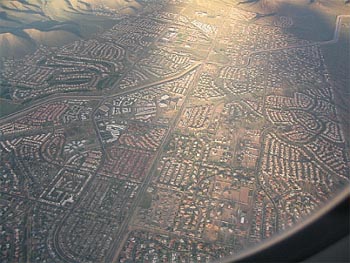 
Phoenix
Phoenix
This collapse is a distinct possibility because humans have not
learned to turn their industrial system into a cycle, as natural
ecosystems do. The least heralded trophic level, the function served
by the detrivores, has not been taken seriously. Even in beginning
ecology lessons this literally lowly level may be ignored. But
besides the natural solar energy, water, carbon, and nitrogen
cycles, the detrivores provide the raw material on which ecosystems
depend. Perhaps the meek shall yet inherit the earth, because worms
certainly create the earth.
The sustainable mode of production
Karl Marx famously predicted that a socialist mode of production
would follow a capitalist mode of production. He based his
historical progression on the relations of production, basically
from slavery to capitalism to socialism. As I have argued in “Why
a Democratic Economy would be a more efficient economy”, an
essential characteristic of an efficient economy would be to create
a society in which firms were operated and owned by their employees.
But this would be one part of a wider transformation to a
sustainable mode of production.
I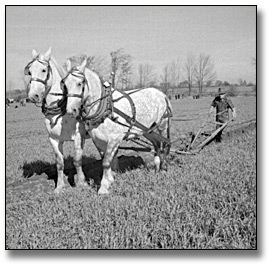 ndeed,
as Dale Allen Pfeiffer points out in “Eating fossil fuels”, the main
mode of production before fossil fuels was one of
slavery, because without fossil fuels slavery is perhaps the only
way to coax enough industrial energy out of humans to make
industrial processes work. Perhaps Max Weber is partly correct to
write of the capitalist spirit of Protestantism, and perhaps Marx is
partly correct to explain the premodern precursors of capitalism.
But capitalism was also made possible by fossil fuels because it
made it possible to free up most human labor from what had
previously been the need to provide the basic energy for the
economic system. By 1870, when both American slavery and Russian
serfdom had been destroyed, the fossil-fuel based industrial system
was taking off. It is therefore scary to contemplate what mode of
production might follow the decline and fall of fossil fuels, unless
the industrial system becomes truly sustainable. ndeed,
as Dale Allen Pfeiffer points out in “Eating fossil fuels”, the main
mode of production before fossil fuels was one of
slavery, because without fossil fuels slavery is perhaps the only
way to coax enough industrial energy out of humans to make
industrial processes work. Perhaps Max Weber is partly correct to
write of the capitalist spirit of Protestantism, and perhaps Marx is
partly correct to explain the premodern precursors of capitalism.
But capitalism was also made possible by fossil fuels because it
made it possible to free up most human labor from what had
previously been the need to provide the basic energy for the
economic system. By 1870, when both American slavery and Russian
serfdom had been destroyed, the fossil-fuel based industrial system
was taking off. It is therefore scary to contemplate what mode of
production might follow the decline and fall of fossil fuels, unless
the industrial system becomes truly sustainable.
There is a long history of the discussion of the ideas of man vs.
nature, or man outside of nature, or man in nature. The first and
second views (held by Marx, by the way), are breathtakingly ignorant
(the more polite label is “cornucopian”). Obviously, if you run out
of something, you can’t make anything that depends on that
something. Or if you destroy the ecosystems that you depend on for
your agriculture and cities, you can’t survive.
But even the third view, that man is a part of nature, has tended
not to view the industrial economy as being part of nature. Of
course, the industrial economy has been the great destroyer of
ecosystems, but this doesn’t mean that an industrial economy is not
part of the ecosystem. After all, a volcano is part of the ecosystem
(although in the long run volcanoes are responsible for much of the
raw material of ecosystems, unlike industrial economies, which turn
useful ecological material into useless ecological poisons).
The preindustrial, indigenous peoples of the earth usually
managed to live in relative harmony with their ecosystems. If the
industrial ecosystem can manage to change from a linear sequence of
mining, processing, and polluting, to a circular system of
processing and recycling, if the snake can grab its own tail, to use
a Native American image, then perhaps humanity can tread the Earth
lightly, even with six billion people.

You can contact Jon Rynn directly on his jonrynn.blogspot.com .
You can also find old blog entries and longer articles at
economicreconstruction.com. Please feel free to reach him at
This email address is being protected from spam bots, you need
Javascript enabled to view it
.
[1] The classic work on the
statistical mechanical nature of economics is Philip Mirowski’s
More heat than light , Cambridge University Press, 1989, from
which many of the ideas of the first paragraphs were taken.
[2] Fixed capital was
defined initially by Adam Smith as, basically, the means of
production, that is, the plant and machinery that was fixed and used
to make more wealth. Circulating capital, according to Smith, are
the intermediate goods that exist within the market before the goods
turn into final goods. Circulating capital, not fixed capital, is
represented in the general equilibrium model.
[3] Joseph Schumpeter’s
phrase, “creative destruction”, is constantly thrown around by
economists, but it is the only major concept of his that they use,
and it does not pervade the conceptual core of economics, which we
are concerned with here.
[4] For a more detailed
discussion of the problems of economics, growth, and capital, see my
dissertation chapter on the subject, available at the following link
.
[5] E. O. Wilson, The
Diversity of Life , 1999.
[6] J. R. McNeill,
Something New Under the Sun; an environmental history of the 20th
century , 2001.
[7] Gunderson and Holling,
Panarchy: Understanding transformations in human and natural
systems , 2001.
This email address is being protected from spam bots, you need
Javascript enabled to view it
|








 Metaphors are
important even if they remain unstated. The modern conception of an
economy is dominated by the theory of neoclassical economics, whose
metaphor is hidden from view for a very good reason: the field would
look ridiculous if its roots were front and center. But in the
spirit of “Know the truth and it will set you free”, your humble
correspondent will attempt to lay bare the foundation of
neoclassical economics, and, after having done so, propose a more
rational view of economic systems.
Metaphors are
important even if they remain unstated. The modern conception of an
economy is dominated by the theory of neoclassical economics, whose
metaphor is hidden from view for a very good reason: the field would
look ridiculous if its roots were front and center. But in the
spirit of “Know the truth and it will set you free”, your humble
correspondent will attempt to lay bare the foundation of
neoclassical economics, and, after having done so, propose a more
rational view of economic systems. More
heat than light
More
heat than light Ecosystems
are not conceived of as a set of similar elements, they are modeled
as a set of functional niches, a set of elements including climate,
landscape, plants, animals or fungi, set within a complex whole. The
pieces all fit together. There are not a large enough number of
niches to enable the use of statistical methods. The largest
aggregation of niches in an ecosystem are called trophic levels,
which is a fancy way of saying that plants produce the main biomass
of an ecosystem; herbivores (mainly) consume what the plants
produce; and carnivores consume the herbivores (sometimes called
secondary consumers). Finally, there are the detrivores such as
worms, fungi and bacteria that break down the dead plant and animal
life, and make the released resources available to the producers in
the form of soil. Within each level there may be greater detail,
such as the various parts of a tree, or depths in a lake or ocean,
and these are considered separate niches.
Ecosystems
are not conceived of as a set of similar elements, they are modeled
as a set of functional niches, a set of elements including climate,
landscape, plants, animals or fungi, set within a complex whole. The
pieces all fit together. There are not a large enough number of
niches to enable the use of statistical methods. The largest
aggregation of niches in an ecosystem are called trophic levels,
which is a fancy way of saying that plants produce the main biomass
of an ecosystem; herbivores (mainly) consume what the plants
produce; and carnivores consume the herbivores (sometimes called
secondary consumers). Finally, there are the detrivores such as
worms, fungi and bacteria that break down the dead plant and animal
life, and make the released resources available to the producers in
the form of soil. Within each level there may be greater detail,
such as the various parts of a tree, or depths in a lake or ocean,
and these are considered separate niches.  Each
niche serves a particular function, and if enough of these functions
collapse, the entire ecosystem will collapse. For instance, at one
point killer whales had eliminated most sea otters from parts of the
pacific northwest. Without sea otters to eat them, the sea urchin
population exploded, almost eliminating the kelp forests that were
critical to the survival of most species. Only by bringing the sea
otter back from the brink was the ecosystem saved. E.O. Wilson calls
species such as the sea otter a keystone species,
because some species are very central to the functioning of an
ecosystem.
Each
niche serves a particular function, and if enough of these functions
collapse, the entire ecosystem will collapse. For instance, at one
point killer whales had eliminated most sea otters from parts of the
pacific northwest. Without sea otters to eat them, the sea urchin
population exploded, almost eliminating the kelp forests that were
critical to the survival of most species. Only by bringing the sea
otter back from the brink was the ecosystem saved. E.O. Wilson calls
species such as the sea otter a keystone species,
because some species are very central to the functioning of an
ecosystem.
 Metaphor
Metaphysics
Metaphor
Metaphysics Ideally,
the raw materials of an industrial system should be almost free.
Iron and silicon, the basis of steel and semiconductors, are both
very abundant in the Earth’s crust. The category of material-making
is often very dependent on much scarcer materials, however. As the
recent rise in commodity prices indicates, we are coming to the end
of the period when raw materials were cheap and easy to find.
Indeed, considering that mining is one of the most environmentally
destructive activities known to man or nature,
Ideally,
the raw materials of an industrial system should be almost free.
Iron and silicon, the basis of steel and semiconductors, are both
very abundant in the Earth’s crust. The category of material-making
is often very dependent on much scarcer materials, however. As the
recent rise in commodity prices indicates, we are coming to the end
of the period when raw materials were cheap and easy to find.
Indeed, considering that mining is one of the most environmentally
destructive activities known to man or nature,

 ndeed,
as Dale Allen Pfeiffer points out in “Eating fossil fuels”, the main
mode of production before fossil fuels was one of
slavery, because without fossil fuels slavery is perhaps the only
way to coax enough industrial energy out of humans to make
industrial processes work. Perhaps Max Weber is partly correct to
write of the capitalist spirit of Protestantism, and perhaps Marx is
partly correct to explain the premodern precursors of capitalism.
But capitalism was also made possible by fossil fuels because it
made it possible to free up most human labor from what had
previously been the need to provide the basic energy for the
economic system. By 1870, when both American slavery and Russian
serfdom had been destroyed, the fossil-fuel based industrial system
was taking off. It is therefore scary to contemplate what mode of
production might follow the decline and fall of fossil fuels, unless
the industrial system becomes truly sustainable.
ndeed,
as Dale Allen Pfeiffer points out in “Eating fossil fuels”, the main
mode of production before fossil fuels was one of
slavery, because without fossil fuels slavery is perhaps the only
way to coax enough industrial energy out of humans to make
industrial processes work. Perhaps Max Weber is partly correct to
write of the capitalist spirit of Protestantism, and perhaps Marx is
partly correct to explain the premodern precursors of capitalism.
But capitalism was also made possible by fossil fuels because it
made it possible to free up most human labor from what had
previously been the need to provide the basic energy for the
economic system. By 1870, when both American slavery and Russian
serfdom had been destroyed, the fossil-fuel based industrial system
was taking off. It is therefore scary to contemplate what mode of
production might follow the decline and fall of fossil fuels, unless
the industrial system becomes truly sustainable.